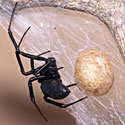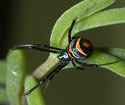|
Latrodectus (button spiders, widow spiders) Life
> Eukaryotes
>
Opisthokonta >
Metazoa
(animals) > Bilateria > Ecdysozoa > Panarthropoda > Tritocerebra >
Arthropoda > Arachnomorpha > Cheliceriformes > Chelicerata > Euchelicerata
> Arachnida > Araneae
> Araneomorpha > Family: Theridiidae
This is a notorious genus in that certain
species are highly toxic and, under rare circumstances, can kill people if they
are bitten. The name widow spider arises from the fact that females often consume the male after mating. There
are 6 species in South Africa, 5 of which occur in the Western Cape. The very common
species, Latrodectus geometricus, or Brown
or Geometric button spider occurs around every home, outside under window ledges, behind
drain pipes, under wood piles etc. Although its bite can sometimes be troublesome, it is
not life threatening as is the case with of most of this group. However, Latrodectus
indistinctus, or the Black Button spider
presents a serious problem. Its venom is neurotoxic (affects the central nervous system).
This spider does not occur around the Cape Peninsula but distribution starts from about
Bellville and extends north and east. Bites used to be very common during the manual
harvesting of corn but these days with mechanised harvesting, bites are quite rare.
The Black Button spider, Latrodectus indistinctus, is always
dark brown to black with a silky appearance. Dorsally the abdomen can be scattered with
white or red flecks or bands or can be unmarked. The Brown Button spider, Latrodectus
geometricus, is very variable in colour ranging from cream, beige, brown, olive green
to black but always with dorsal geometric markings that radiate down the sides of the
abdomen. Sometimes the markings on Latrodectus geometricus are not that
apparent on those that are darkly coloured or black and the latter could be
confused with Latrodectus
indistinctus. However, the 2 species can always be differentiated by the orange
hour-glass marking on the underside of Latrodectus geometricus while Latrodectus
indistinctus has the red stripe/s on the dorsal side at the end of the abdomen
above
the spinnerets. This stripe/s radiates up the abdomen but as the spider grows, this
stripe/s reduces with each moult ultimately leaving an indistinct mark, hence the name Latrodectus
indistinctus. A further difference is the egg sac. Latrodectus geometricus has
a spiked egg sac while that of Latrodectus indistinctus is smooth.
Button spiders are very timid, usually retreating when disturbed or
dropping to the ground and playing dead. Bites result from
handling or when they are trapped and squeezed.
The main symptoms of Latrodectism (Button spider envenomation):
sharp burning pain at the site
pain spreads to lymph nodes within 15 minutes
severe muscle pain and cramps within an hour, resulting in tightness
in the chest and difficulty with walking
anxiety, sweating, fever, slurred speech, nausea and headaches.
Symptoms are less severe with the Brown button spider.
Less than 5% of untreated cases result in death, usually as a
result of respiratory failure. In fact, there have been no deaths from button
spiders in the last 4 to 5 decades. Those more severely
affected are children (smaller blood volume) and the elderly who might suffer respiratory
or heart failure. All Latrodectus bites should be treated and monitored.
Species native to southern Africa
|
Latrodectus cinctus
Blackwall, 1865
Recorded from Africa, Cape Verde and Kuwait. |
|
Latrodectus geometricus
(Brown widow, Geometric button spider)
C.L. Koch, 1841
Cosmopolitan. |
 |
Latrodectus indistinctus
(Black button spider) O.P.-Cambridge, 1904
Namibia, South Africa. |
 |
|
Latrodectus karrooensis
Smithers, 1944
South Africa |
|
|
Latrodectus
renivulvatus
Dahl, 1902
Africa, Saudi Arabia, Yemen |
 |
|
Latrodectus rhodesiensis
Mackay, 1972
Southern Africa. |
|
Text and images by Norman Larsen
© |
